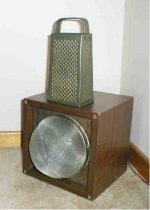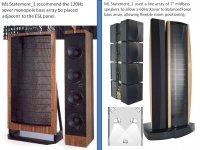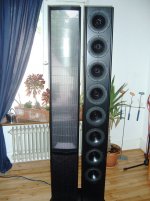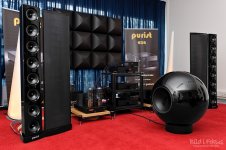Woofers causing membrane modulation in stats
I'm having a problem with my dipole line array subs, they modulate the membranes of the stats when I play bass heavy material loud. Moving the subs away from the stats seem to work to some extent, but for example the right subwoofer modulates the left (and right) stat for some reason.
Subs are U-frame dipoles with 18" drivers:
The membrane is 3,5µm and the lowest resonance is ~36Hz, so the tension is not the greatest but it can withstand 4,7kV bias with no problems, propably much more.
Is there any way around this problem other than moving to a bigger room and leave at least 1m distance between the stats and the woofers? Would 6µm membrane with higher tension be less problematic or would it be almost just as unstanble at it's Fs? I'm really liking the sound with 3,5µm, would not want to change them. Or are dipole woofers ultimately not the best partners for stats, because they generate more pressure changes (than box subs) or something that modulates the membrane?
I'm having a problem with my dipole line array subs, they modulate the membranes of the stats when I play bass heavy material loud. Moving the subs away from the stats seem to work to some extent, but for example the right subwoofer modulates the left (and right) stat for some reason.
Subs are U-frame dipoles with 18" drivers:
An externally hosted image should be here but it was not working when we last tested it.
The membrane is 3,5µm and the lowest resonance is ~36Hz, so the tension is not the greatest but it can withstand 4,7kV bias with no problems, propably much more.
Is there any way around this problem other than moving to a bigger room and leave at least 1m distance between the stats and the woofers? Would 6µm membrane with higher tension be less problematic or would it be almost just as unstanble at it's Fs? I'm really liking the sound with 3,5µm, would not want to change them. Or are dipole woofers ultimately not the best partners for stats, because they generate more pressure changes (than box subs) or something that modulates the membrane?
Last edited:
I tested it with CB subwoofers and the result was the same - the membrane excites near it's Fs. So the reason is not the "eddy currents" around the dipole, but it's just the loud bass near the membrane's Fs (or loud, wide range transients like a bass drum).
I quess there is no way around this (without sacrificing SQ and/or sensitivity) than move to a bigger room and place the stats to dead angle on the side of the (dipole) subs and leave at least 0,5m distance between them.
On the other hand, the modulation is propably not going to kill the membranes, so should one worry about it too much; just turn a tad quiter when you hear the membranes hitting the stators🙄😉.
I quess there is no way around this (without sacrificing SQ and/or sensitivity) than move to a bigger room and place the stats to dead angle on the side of the (dipole) subs and leave at least 0,5m distance between them.
On the other hand, the modulation is propably not going to kill the membranes, so should one worry about it too much; just turn a tad quiter when you hear the membranes hitting the stators🙄😉.
Legis,
You may find useful information by reading the Martin Logan Statement 1 and 2 manuals which you can download off the web. The ML Statement 1 is similar to your panels, but uses a monopole bass line array. ML recommends keeping the Statement 1 woofers near to the panels.(pdf) The ML Statement 2 woofer "balanced force" line array can be configured as dipole, bipole, or cardiod radiation. ML suggests putting these bass line arrays in the room corners with the null vector pointed toward the soundstage.(picture)
For fragile dipole ribbons I use an H-frame with 8" deep front/rear wings for a three woofer line array, and place it directly next to the ribbon linesources, but on the outside of the soundstage angled toward the side wall for extra time delay and bass room mode control. From my experience, the H-frame significantly reduced bass wind vibrating the ribbons over a flat dipole baffle. I use Ficus indoor trees as rear diffusors behind the ribbons. These trees both absorb and scatter the bass wave. I favor rear wave diffusion so the upper frequency energy is not absorbed, but scattered into several different vectors to enrich the room interaction.
Dipoles add the room into the listening equation. Horns subtract the room out of the listening equation. Modern controlled directivity monopoles with good diffraction control use long delay reflections for location clues.
You may find useful information by reading the Martin Logan Statement 1 and 2 manuals which you can download off the web. The ML Statement 1 is similar to your panels, but uses a monopole bass line array. ML recommends keeping the Statement 1 woofers near to the panels.(pdf) The ML Statement 2 woofer "balanced force" line array can be configured as dipole, bipole, or cardiod radiation. ML suggests putting these bass line arrays in the room corners with the null vector pointed toward the soundstage.(picture)
For fragile dipole ribbons I use an H-frame with 8" deep front/rear wings for a three woofer line array, and place it directly next to the ribbon linesources, but on the outside of the soundstage angled toward the side wall for extra time delay and bass room mode control. From my experience, the H-frame significantly reduced bass wind vibrating the ribbons over a flat dipole baffle. I use Ficus indoor trees as rear diffusors behind the ribbons. These trees both absorb and scatter the bass wave. I favor rear wave diffusion so the upper frequency energy is not absorbed, but scattered into several different vectors to enrich the room interaction.
Dipoles add the room into the listening equation. Horns subtract the room out of the listening equation. Modern controlled directivity monopoles with good diffraction control use long delay reflections for location clues.
Attachments
Hi,
the chance of driving the ESL membrane into the stators is greatly reduced in the Statement2 design -which I similarly use in my design- by 3 mechanisms.
a) airgap between woofer and panel.
b) very high membrane tension. As a sideeffect this makes necessary a
c) dipole woofer-midrange between woofers and panel (which also reacts much less sensitive on the near placed woofer).
The dynamic driver dipole tower acts as a filler driver and kind of mechnical buffer between Panel and woofer. As with many aspects in ESL design, if all is done correctly, parameters fit into place, like pieces of a good mechanical watch. ML named this dipolar transistion tower. I think the name says it all.
Legis´s design reminds of the earlier ML Statement, which featured a very large panel and a CB bass tower. ML probabely experienced the same problems as he does. The Panel was crossed over at very low 120Hz and was specced to reach down to 80Hz.
jauu
Calvin
ps:
the chance of driving the ESL membrane into the stators is greatly reduced in the Statement2 design -which I similarly use in my design- by 3 mechanisms.
a) airgap between woofer and panel.
b) very high membrane tension. As a sideeffect this makes necessary a
c) dipole woofer-midrange between woofers and panel (which also reacts much less sensitive on the near placed woofer).
The dynamic driver dipole tower acts as a filler driver and kind of mechnical buffer between Panel and woofer. As with many aspects in ESL design, if all is done correctly, parameters fit into place, like pieces of a good mechanical watch. ML named this dipolar transistion tower. I think the name says it all.
Legis´s design reminds of the earlier ML Statement, which featured a very large panel and a CB bass tower. ML probabely experienced the same problems as he does. The Panel was crossed over at very low 120Hz and was specced to reach down to 80Hz.
jauu
Calvin
ps:
Balanced Force implies bipolar or -because of the long wavelengths at such low freqs- monopolar distribution character. Apart from the first of the possible four stacked bass-modules per channel, the modules only featured two binding posts, hence no possibility to configure the single modules as dipoles or cardiods. The drivers within a module are simply paralleledThe ML Statement 2 woofer "balanced force" line array can be configured as dipole, bipole, or cardiod radiation.
Last edited:
Legis, do you have space to arrange the woofers' axes so that they are in the same plane as the ESL panels? (to attempt to balance the F/R pressure on the ESL membrane)
Yes the best solution would be placing the woofers on the sides next to the panels, where the dipole has a null. This does not work in my small room however, the basses are under 1 meter away from the front wall and the null points do not build up on the sides. This apartment is not the final solution luckily, I need big dedicated listening room for these in the future, girl friend might also like it😀.
Not just on the sides of the panels, but facing the edge of the panels, so that both front and rear sides of the panels get the same pressure from the bass.
I will try that setting.. So dipole's sides facing the spot, cannot really predict how it will sound. I have noticed that it's the air pressure that modulates the membrane (near the membrane's Fs). At first I though it was the eddy currents around the dipole, but it's not the only cause.
I don't expect this arrangement to be ideal, but perhaps it will avoid unequal air pressure moving the ESL.
These eddy currents? ESLs are not affected by magnetism...
These eddy currents? ESLs are not affected by magnetism...
^I don't know the correct term in english, maybe acoustic eddy currents😀 I mean the circulating waves/acoustic cancellation around the dipole. In other terms the air moving around the dipole that is not sound pressure per se, but just the air "moving".
Last edited:
Hi Legis,
Beautiful system you've built there.
If, as you said in the original post, the right subwoofer is affecting both ESL panels, I wonder if that woofer is positioned to excite strongly a room resonance which happens to overlap with your ESL panel resonance frequency. That might explain why woofer/panel proximity isn't the only important parameter (if I've understood your description correctly). If you can identify the fundamental resonance of your ESL panels and drive the right woofer at that frequency with a sine wave, you might be able to walk around the room and determine if there's a hot spot where the ESLs are located.
I don't see any need to switch diaphragm thickness. If it turns out you want to move the resonance frequency you should be able to do that by adjusting the tension while retaining the thin diaphragms you like.
Few
Beautiful system you've built there.
If, as you said in the original post, the right subwoofer is affecting both ESL panels, I wonder if that woofer is positioned to excite strongly a room resonance which happens to overlap with your ESL panel resonance frequency. That might explain why woofer/panel proximity isn't the only important parameter (if I've understood your description correctly). If you can identify the fundamental resonance of your ESL panels and drive the right woofer at that frequency with a sine wave, you might be able to walk around the room and determine if there's a hot spot where the ESLs are located.
I don't see any need to switch diaphragm thickness. If it turns out you want to move the resonance frequency you should be able to do that by adjusting the tension while retaining the thin diaphragms you like.
Few
Those look awesome, Legis! The skill and ingenuity and go-for-it motivation on this forum never ceases to amaze me. With all that gear in the living room, I'm guessing you're not married? lol
Thanks guys. I'm not married, but I live under the same room with my gf. She should be awarded with lowest waf of the year trophy😉🙂.
Here's her trophy. Now where's my dinner?!She should be awarded with lowest waf of the year trophy.
Attachments
Is there any way around this problem other than moving to a bigger room and leave at least 1m distance between the stats and the woofers? Would 6µm membrane with higher tension be less problematic or would it be almost just as unstanble at it's Fs? I'm really liking the sound with 3,5µm, would not want to change them. Or are dipole woofers ultimately not the best partners for stats, because they generate more pressure changes (than box subs) or something that modulates the membrane?
What Xover frequency and slope do you use between the bass line array and ESL panel? For my ribbon linesource I found it necessary to use a steep LR8 slope at 100Hz or above to remove bass signals from the ribbons. Perhaps some of your ESL panel bass vibration is from the signal.
CHEAP EXPERIMENT: You could use carboard and tape to convert your U-frame bass line array into an H-frame for a bass wind control experiment. I use H-frame bass line arrays with my ribbon linesources because the H-frame both blocks some of the bass wind and also provides the same symmetric figure-8 dipole radiation pattern as the ribbons. An H-frame simplifies reverse direction mounting of half of the woofers to reduce the mechanical push-pull imperfection distortion.
1) The top rated ESL speakers use a 2um Mylar film, so you naturally do not want to change your panel film thickness above the current 3.5um. A thicker film would reduce high frequency extension and overall dynamics.
2) Dipole woofers do not pressurize the room like a sealed box woofer does. Dipole woofers generate the same figure-8 radiation patern as the main ESL panel. Hence, dipole woofers are both the natural and ideal partner for fragile dipole ESL or ribbon M-T.
3) JAES data proved that a listener can physically locate in space the source of bass signals above ~60Hz. Hence, the bass line array must be physically close to the main ESL panel. The Lambda/4 minimal distance spacing rule for a 100Hz Xover frequency is 32". Your wide ESL panel and wide 18" U-frame bass line array sum wider than 32", so they should be physicall adjacent for optimum sound. (( ML Statement_1 recommends placing 120Hz Xover bass array next to ESL panel. ML Satement_2 added 7" midbass line array to allow a 60Hz xover to the bass array in order to support flexible room placement.))
Attachments
Hi,
You may have seen my earlier prototypes with dipolar bass towers (with 8x 8" resp. 8x6.5") in close proximity to the panels with just a small slot to let air pass through. I never had any probs with air movement blowing the ESL-membrane into the stators. The main difference to Legis beeing the high mechanical tension of the membrane and as such a higher xover freq.
A steep xover flank also might help keeping the overlap of both branches small, but ML used monopolar distributing basses in close proximity with their panels and soft xover flanks without any issues. But they work with high xoverfreqs of 400-500Hz.
A dipolar bass is advantageous here because of its natural steep first rolloff (null), but does only allow for a xover of 250Hz or less
I´m afraid that there will be no really satiyfying solution as the system is. I assume that only a raise in Fs of the panel might help, eventually even with a third way filler-driver dipolar tower as in the Statement2 and my purist ESL -and I use a very powerful, potent woofer too.
All else wll probabely restrict heavily the possible dynamic range.
jauu
Calvin
You may have seen my earlier prototypes with dipolar bass towers (with 8x 8" resp. 8x6.5") in close proximity to the panels with just a small slot to let air pass through. I never had any probs with air movement blowing the ESL-membrane into the stators. The main difference to Legis beeing the high mechanical tension of the membrane and as such a higher xover freq.
A steep xover flank also might help keeping the overlap of both branches small, but ML used monopolar distributing basses in close proximity with their panels and soft xover flanks without any issues. But they work with high xoverfreqs of 400-500Hz.
A dipolar bass is advantageous here because of its natural steep first rolloff (null), but does only allow for a xover of 250Hz or less
I´m afraid that there will be no really satiyfying solution as the system is. I assume that only a raise in Fs of the panel might help, eventually even with a third way filler-driver dipolar tower as in the Statement2 and my purist ESL -and I use a very powerful, potent woofer too.
All else wll probabely restrict heavily the possible dynamic range.
jauu
Calvin
Attachments
Last edited:
What Xover frequency and slope do you use between the bass line array and ESL panel? For my ribbon linesource I found it necessary to use a steep LR8 slope at 100Hz or above to remove bass signals from the ribbons. Perhaps some of your ESL panel bass vibration is from the signal.
3) JAES data proved that a listener can physically locate in space the source of bass signals above ~60Hz. Hence, the bass line array must be physically close to the main ESL panel. The Lambda/4 minimal distance spacing rule for a 100Hz Xover frequency is 32". Your wide ESL panel and wide 18" U-frame bass line array sum wider than 32", so they should be physicall adjacent for optimum sound. (( ML Statement_1 recommends placing 120Hz Xover bass array next to ESL panel. ML Satement_2 added 7" midbass line array to allow a 60Hz xover to the bass array in order to support flexible room placement.))
Naturally some movement is caused by the bass signal driving the membrane, but the bass arrays move the membranes way more. I actually searched the places for the bass arrays with the panels muted and watched and listened with right sine wave playing what position gave the best result.
What do you mean by the esl panel and the woofers summing larger than 32" is a bad thing? Thinking the labda/4 at 20kHz with 3ft x 6ft panel and we are at quite ridiculous numbers.😀
I have build line arrays and know the woofer spacing of labda/4, that determines the upper "limit"of usable range, and that is calculated with center-center distance. However I think in this case it's the distance between the radiating areas what matters, and thus the distance is calculated from edge to edge. Bass drivers have pistonic movement with bass frequencies, so the distance is calculated from the edge of the woofer. Naturally the whole esl panel also radiates so the distance is calculated also from it's edge.
After I move away from this student apartment and get dedicated and bigger listening room I will place the woofers on the outer or inner side on the panels, keeping maybe 20-80cm distance to the panels.
Last edited:
I´m afraid that there will be no really satiyfying solution as the system is. I assume that only a raise in Fs of the panel might help, eventually even with a third way filler-driver dipolar tower as in the Statement2 and my purist ESL -and I use a very powerful, potent woofer too.
All else wll probabely restrict heavily the possible dynamic range.
jauu
Calvin
Nice pictures Calvin. I'd say the dynamic restriction is not that severe. I can listen at ~105-110dB peaks at the sweetspot with all material except very (low) bass heavy tracks (like Wiz Khalifa's On My Level being one). I don't listen louder than that so basically everything is fine for my usage. Anyway when I get the chance to put the esl panels to the null points of the woofers on their side, the situations hopefully gets better.
Hi,
On the other hand the ESLs SPL will drop considerably below 100Hz. So there´s a range of app. +-1 octave around the xover freq where both branches add to the acoustic signal and where the phase relationship decides about the resulting SPL and the phase relationship depends on the distance of the two sources.
jauu
Calvin
Its about the distance between two sound generating sources playing the same signal, i.e around the xover frequency. Larger distances between the sources lead to wobbles in the summed amplitude response and comb-filter effects over varying listening angles. If You cross over the SPL of the basses at 100Hz the SPL at 200Hz and higher is already so low, that it doesn´t play a role anymore.What do you mean by the esl panel and the woofers summing larger than 32" is a bad thing?
On the other hand the ESLs SPL will drop considerably below 100Hz. So there´s a range of app. +-1 octave around the xover freq where both branches add to the acoustic signal and where the phase relationship decides about the resulting SPL and the phase relationship depends on the distance of the two sources.
jauu
Calvin
- Status
- Not open for further replies.
- Home
- Loudspeakers
- Planars & Exotics
- Woofers' membrane modultion




